TOYOTA RAV4 EV 2014 1.G Owners Manual
Manufacturer: TOYOTA, Model Year: 2014, Model line: RAV4 EV, Model: TOYOTA RAV4 EV 2014 1.GPages: 521, PDF Size: 7.44 MB
Page 471 of 521
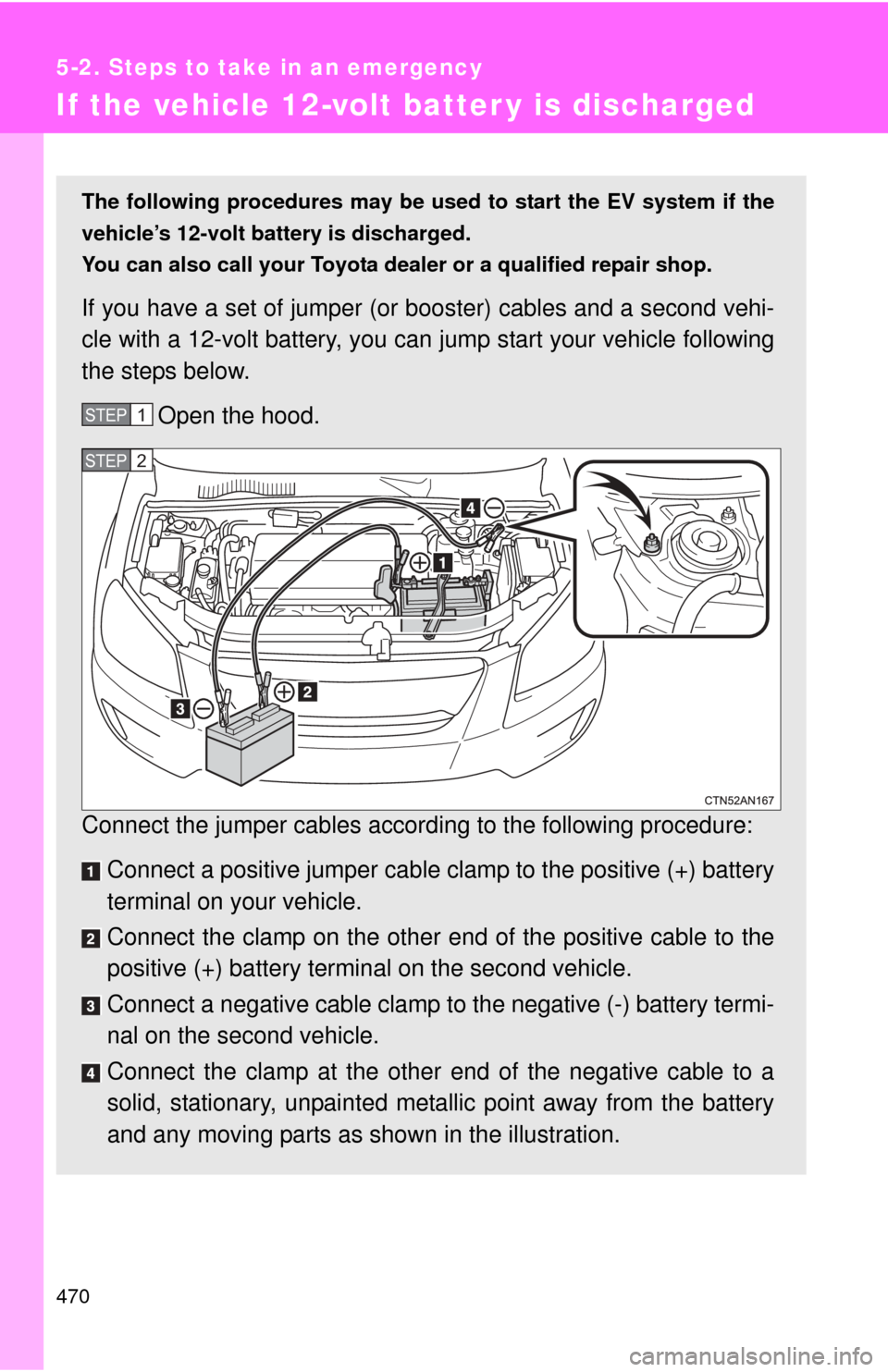
470
5-2. Steps to take in an emergency
If the vehicle 12-volt batter y is discharged
The following procedures may be used to start the EV system if the
vehicle’s 12-volt battery is discharged.
You can also call your Toyota deal er or a qualified repair shop.
If you have a set of jumper (or booster) cables and a second vehi-
cle with a 12-volt battery, you c an jump start your vehicle following
the steps below.
Open the hood.
Connect the jumper cables accord ing to the following procedure:
Connect a positive jumper cable clamp to the positive (+) battery
terminal on your vehicle.
Connect the clamp on the other e nd of the positive cable to the
positive (+) battery termin al on the second vehicle.
Connect a negative cable clamp to the negative (-) battery termi-
nal on the second vehicle.
Connect the clamp at the other end of the negative cable to a
solid, stationary, unpainted metallic point away from the battery
and any moving parts as shown in the illustration.
STEP 1
STEP 2
Page 472 of 521
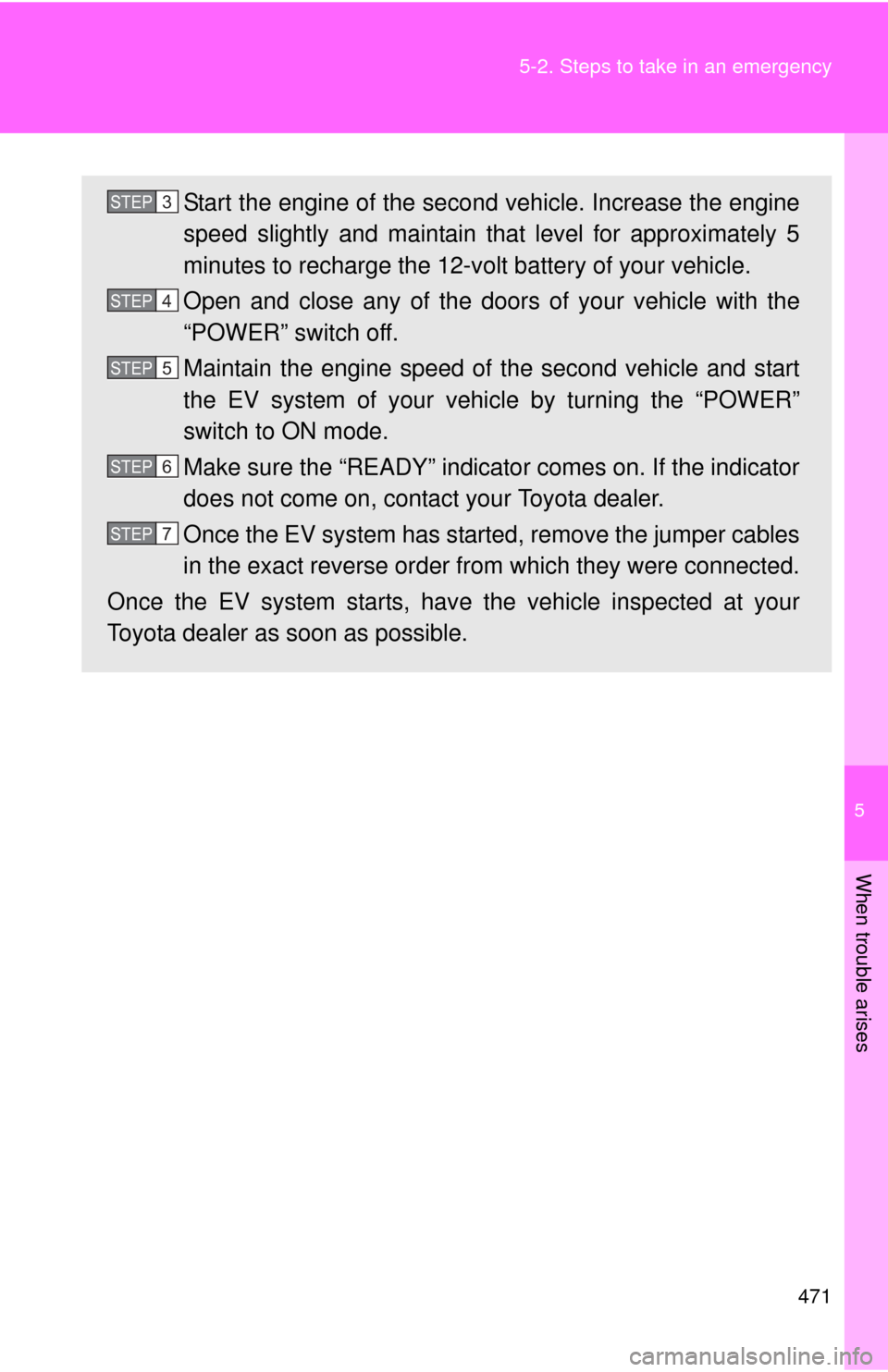
5
When trouble arises
471
5-2. Steps to take in an emergency
Start the engine of the second vehicle. Increase the engine
speed slightly and maintain that level for approximately 5
minutes to recharge the 12-v
olt battery of your vehicle.
Open and close any of the door s of your vehicle with the
“POWER” switch off.
Maintain the engine speed of the second vehicle and start
the EV system of your vehicle by turning the “POWER”
switch to ON mode.
Make sure the “READY” indicator comes on. If the indicator
does not come on, contact your Toyota dealer.
Once the EV system has started, remove the jumper cables
in the exact reverse order from which they were connected.
Once the EV system starts, hav e the vehicle inspected at your
Toyota dealer as soon as possible.STEP 3
STEP 4
STEP 5
STEP 6
STEP 7
Page 473 of 521

472 5-2. Steps to take in an emergency
â– Starting the EV system when the 12-volt battery is discharged
The EV system cannot be started by push-starting.
â– To prevent 12-volt battery discharge
â—ŹTurn off the headlights and the navigation system while the EV system is
off.
â—Ź Turn off any unnecessary electrical components when the vehicle is run-
ning at a low speed for an extended period, such as in heavy traffic.
â– When the 12-volt battery is removed or discharged
â—ŹThe EV system may not start. (ď‚®P. 363)
â—Ź If the 12-volt battery discharges while the shift position is in P, it may not
be possible to shift the shift position to other positions.
In this case, the vehicle cannot be moved without lifting both front wheels
because the front wheels will be locked. ( ď‚®P. 413)
â—Ź The power windows must be initialized. ( ď‚®P. 147)
â– Charging the 12-volt battery
The electricity stored in the 12-volt battery will discharge gradually even
when the vehicle is not in use, due to natural discharge and the draining
effects of certain electrical appliances. If the vehicle is left for a long time, the
12-volt battery may discharge, and the EV system may be unable to start.
(The 12-volt battery recharges automatically while the EV system is operat-
ing.)
Page 474 of 521
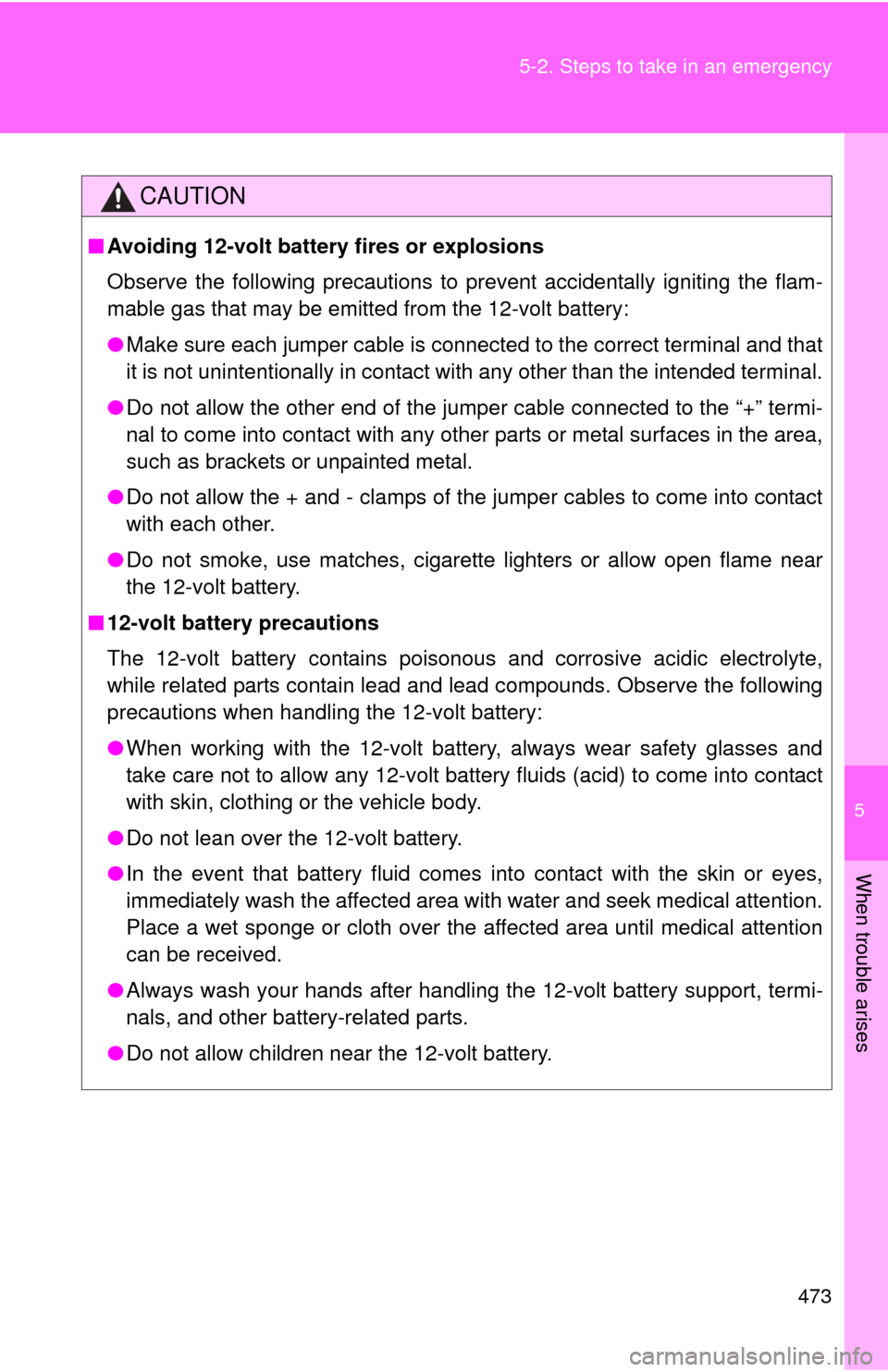
5
When trouble arises
473
5-2. Steps to take in an emergency
CAUTION
â–
Avoiding 12-volt battery fires or explosions
Observe the following precautions to prevent accidentally igniting the flam-
mable gas that may be emitted from the 12-volt battery:
â—ŹMake sure each jumper cable is connected to the correct terminal and that
it is not unintentionally in contact with any other than the intended terminal.
● Do not allow the other end of the jumper cable connected to the “+” termi-
nal to come into contact with any other parts or metal surfaces in the area,
such as brackets or unpainted metal.
â—Ź Do not allow the + and - clamps of the jumper cables to come into contact
with each other.
â—Ź Do not smoke, use matches, cigarette lighters or allow open flame near
the 12-volt battery.
â– 12-volt battery precautions
The 12-volt battery contains poisonous and corrosive acidic electrolyte,
while related parts contain lead and lead compounds. Observe the following
precautions when handling the 12-volt battery:
â—ŹWhen working with the 12-volt battery, always wear safety glasses and
take care not to allow any 12-volt battery fluids (acid) to come into contact
with skin, clothing or the vehicle body.
â—Ź Do not lean over the 12-volt battery.
â—Ź In the event that battery fluid comes into contact with the skin or eyes,
immediately wash the affected area with water and seek medical attention.
Place a wet sponge or cloth over the affected area until medical attention
can be received.
â—Ź Always wash your hands after handling the 12-volt battery support, termi-
nals, and other battery-related parts.
â—Ź Do not allow children near the 12-volt battery.
Page 475 of 521

474 5-2. Steps to take in an emergency
NOTICE
â– When handling jumper cables
When connecting the jumper cables, ensure that they do not become entan-
gled in the cooling fans or belt.
Page 476 of 521
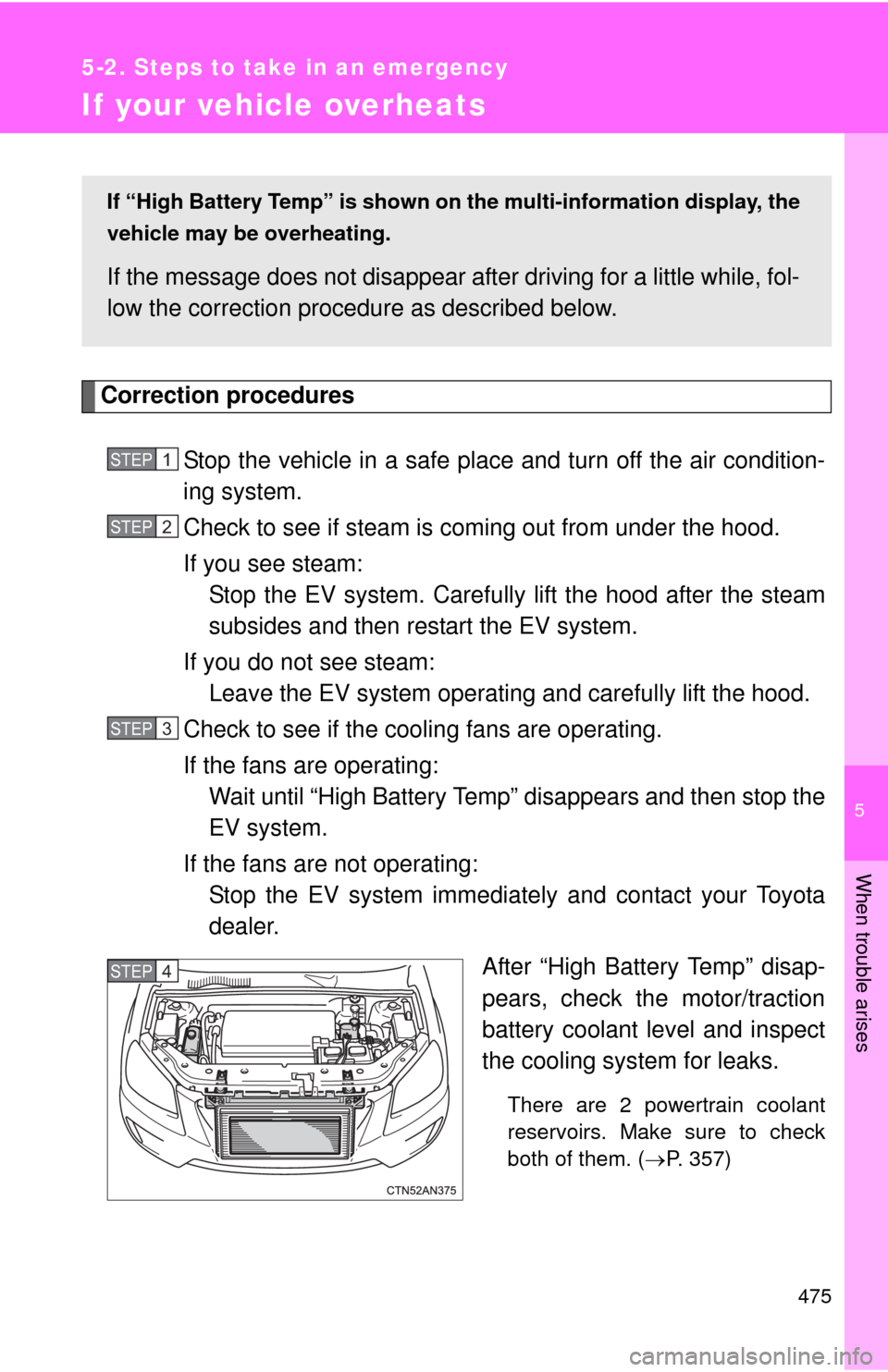
5
When trouble arises
475
5-2. Steps to take in an emergency
If your vehicle overheats
Correction proceduresStop the vehicle in a safe place and turn off the air condition-
ing system.
Check to see if steam is coming out from under the hood.
If you see steam: Stop the EV system. Carefully lift the hood after the steam
subsides and then restart the EV system.
If you do not see steam: Leave the EV system operating and carefully lift the hood.
Check to see if the cooling fans are operating.
If the fans are operating: Wait until “High Battery Temp” disappears and then stop the
EV system.
If the fans are not operating: Stop the EV system immediately and contact your Toyota
dealer.
After “High Battery Temp” disap-
pears, check the motor/traction
battery coolant level and inspect
the cooling system for leaks.
There are 2 powertrain coolant
reservoirs. Make sure to check
both of them. (ď‚®P. 357)
If “High Battery Temp” is shown on the multi-information display, the
vehicle may be overheating.
If the message does not disappear after driving for a little while, fol-
low the correction procedu re as described below.
STEP 1
STEP 2
STEP 3
STEP 4
Page 477 of 521
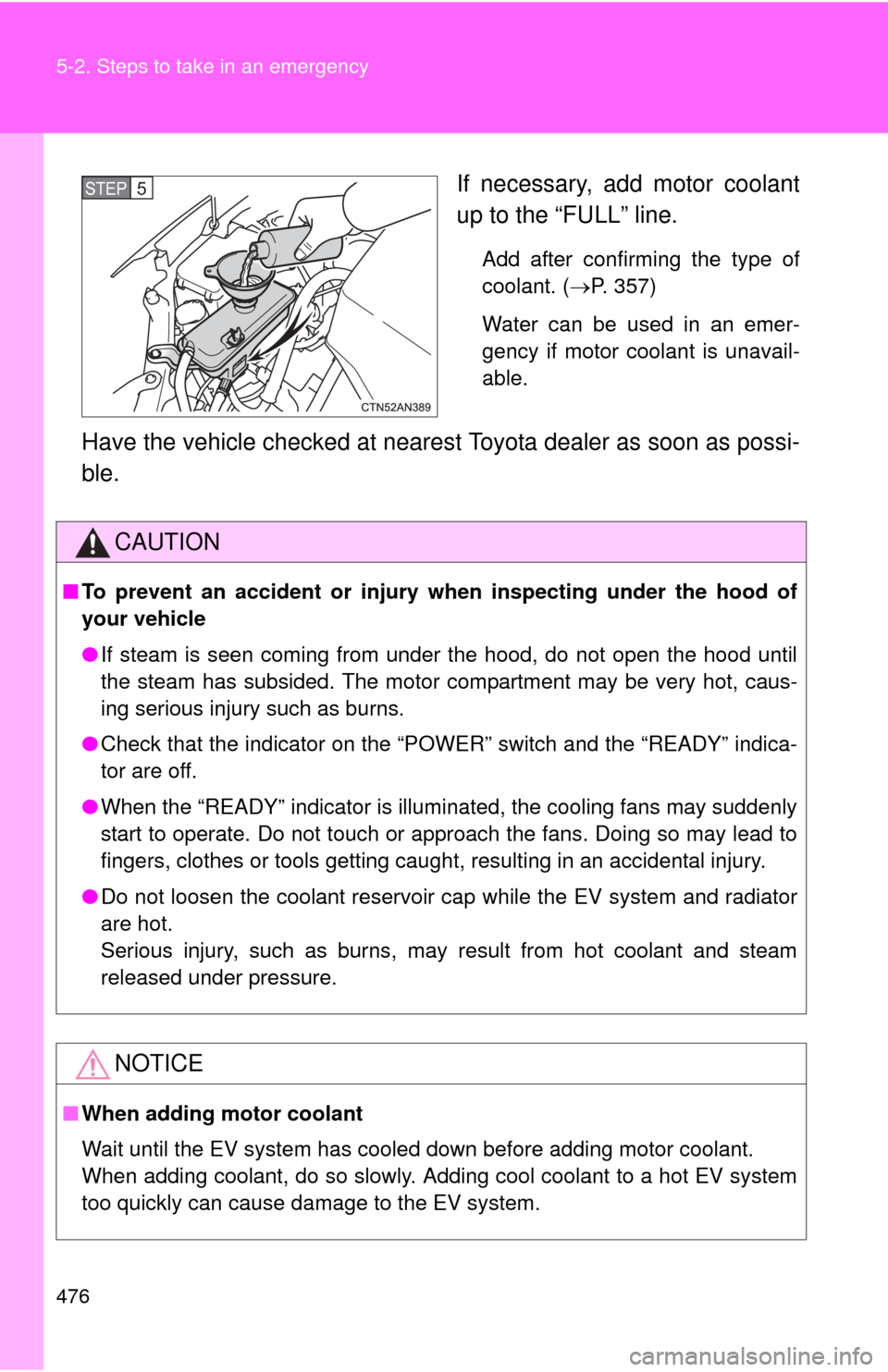
476 5-2. Steps to take in an emergency
If necessary, add motor coolant
up to the “FULL” line.
Add after confirming the type of
coolant. (ď‚®P. 357)
Water can be used in an emer-
gency if motor coolant is unavail-
able.
Have the vehicle checked at nearest Toyota dealer as soon as possi-
ble.
STEP 5
CAUTION
â– To prevent an accident or injury when inspecting under the hood of
your vehicle
â—Ź If steam is seen coming from under the hood, do not open the hood until
the steam has subsided. The motor compartment may be very hot, caus-
ing serious injury such as burns.
● Check that the indicator on the “POWER” switch and the “READY” indica-
tor are off.
● When the “READY” indicator is illuminated, the cooling fans may su\
ddenly
start to operate. Do not touch or approach the fans. Doing so may lead to
fingers, clothes or tools getting caught, resulting in an accidental injury.
â—Ź Do not loosen the coolant reservoir cap while the EV system and radiator
are hot.
Serious injury, such as burns, may result from hot coolant and steam
released under pressure.
NOTICE
â– When adding motor coolant
Wait until the EV system has cooled down before adding motor coolant.
When adding coolant, do so slowly. Adding cool coolant to a hot EV system
too quickly can cause damage to the EV system.
Page 478 of 521
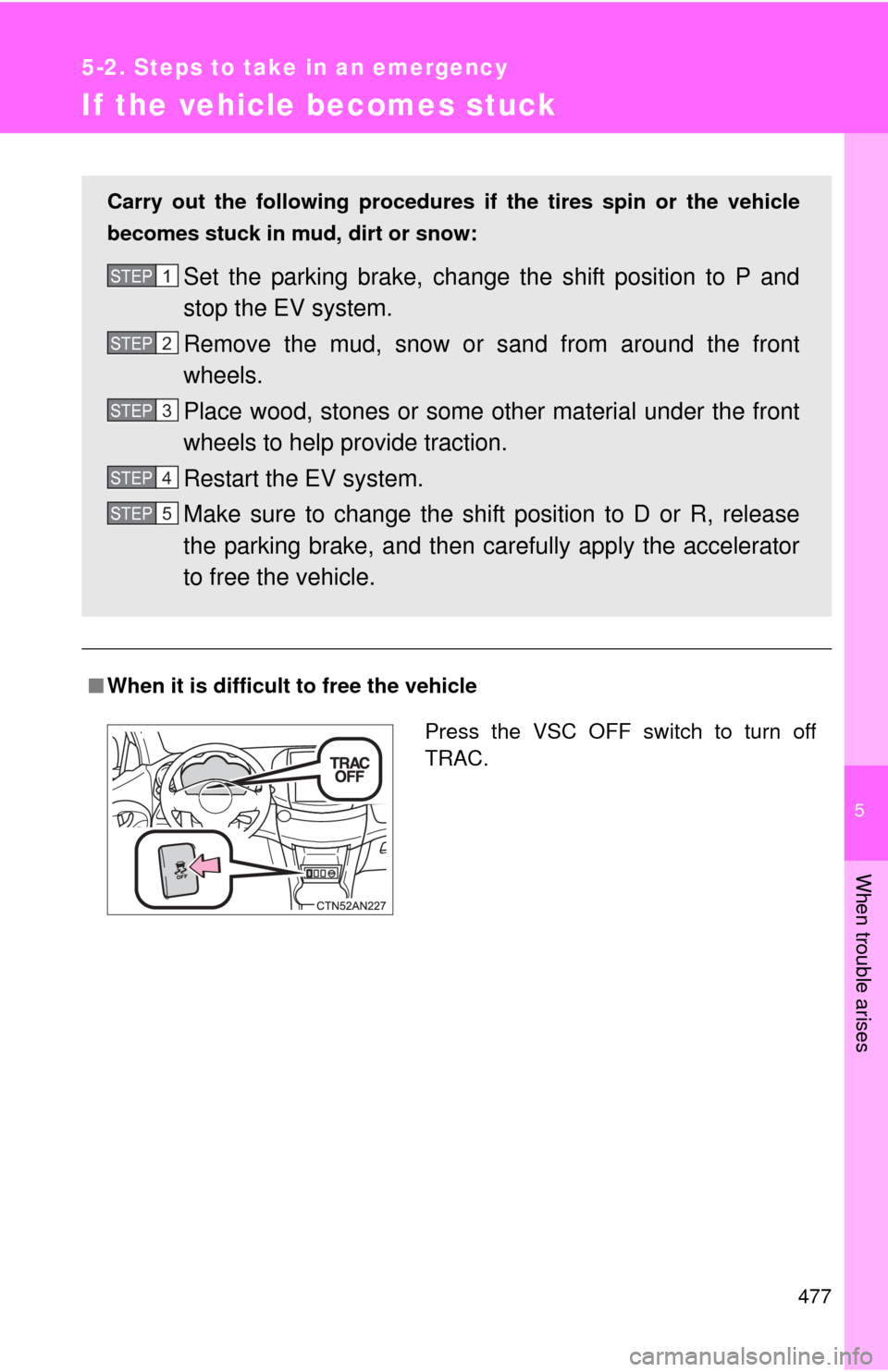
5
When trouble arises
477
5-2. Steps to take in an emergency
If the vehicle becomes stuck
â– When it is difficult to free the vehicle
Carry out the following procedures if the tires spin or the vehicle
becomes stuck in mud, dirt or snow:
Set the parking brake, change the shift position to P and
stop the EV system.
Remove the mud, snow or sand from around the front
wheels.
Place wood, stones or some other material under the front
wheels to help provide traction.
Restart the EV system.
Make sure to change the shift position to D or R, release
the parking brake, and then carefully apply the accelerator
to free the vehicle.STEP 1
STEP 2
STEP 3
STEP 4
STEP 5
Press the VSC OFF switch to turn off
TRAC.
Page 479 of 521
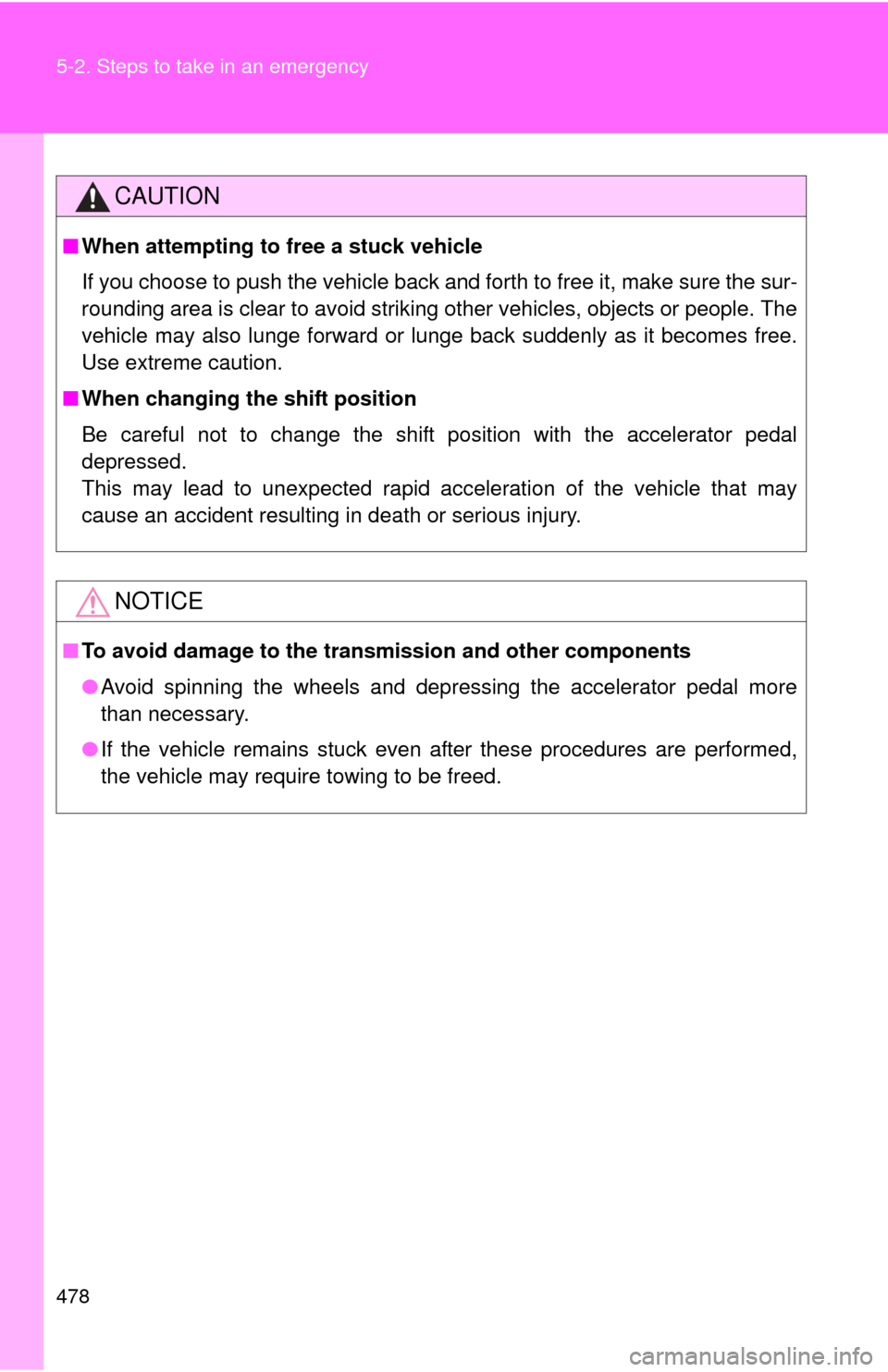
478 5-2. Steps to take in an emergency
CAUTION
â– When attempting to free a stuck vehicle
If you choose to push the vehicle back and forth to free it, make sure the sur-
rounding area is clear to avoid striking other vehicles, objects or people. The
vehicle may also lunge forward or lunge back suddenly as it becomes free.
Use extreme caution.
â– When changing the shift position
Be careful not to change the shift position with the accelerator pedal
depressed.
This may lead to unexpected rapid acceleration of the vehicle that may
cause an accident resulting in death or serious injury.
NOTICE
â– To avoid damage to the transmission and other components
â—ŹAvoid spinning the wheels and depressing the accelerator pedal more
than necessary.
â—Ź If the vehicle remains stuck even after these procedures are performed,
the vehicle may require towing to be freed.
Page 480 of 521
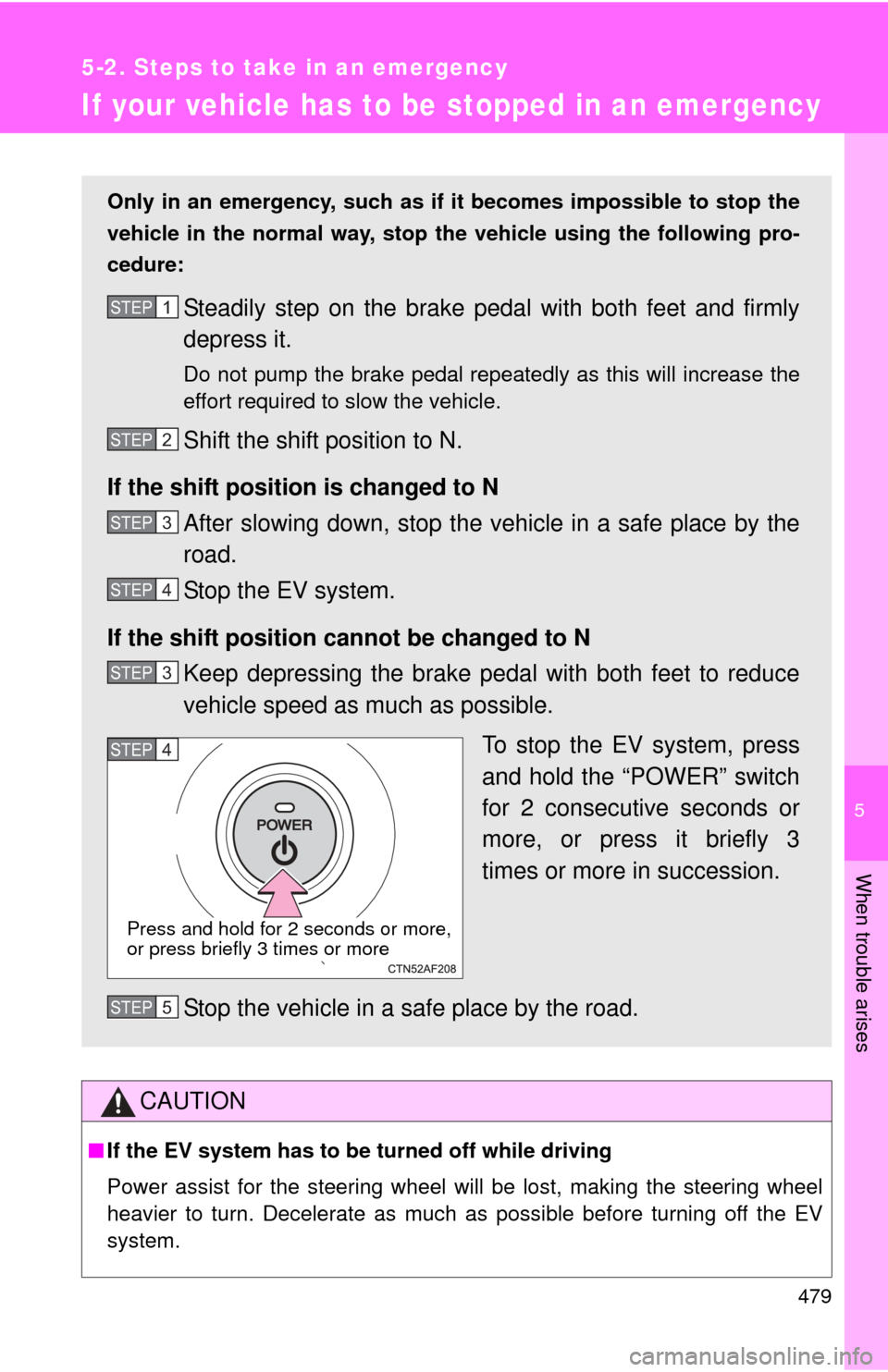
5
When trouble arises
479
5-2. Steps to take in an emergency
If your vehicle has to be stopped in an emergency
CAUTION
â– If the EV system has to be turned off while driving
Power assist for the steering wheel will be lost, making the steering wheel
heavier to turn. Decelerate as much as possible before turning off the EV
system.
Only in an emergency, such as if it becomes impossible to stop the
vehicle in the normal way, stop the vehicle using the following pro-
cedure:
Steadily step on the brake pedal with both feet and firmly
depress it.
Do not pump the brake pedal repeatedly as this will increase the
effort required to slow the vehicle.
Shift the shift position to N.
If the shift position is changed to N After slowing down, stop the vehi cle in a safe place by the
road.
Stop the EV system.
If the shift position cannot be changed to N Keep depressing the brake pedal with both feet to reduce
vehicle speed as much as possible.
To stop the EV system, press
and hold the “POWER” switch
for 2 consecutive seconds or
more, or press it briefly 3
times or more in succession.
Stop the vehicle in a safe place by the road.
STEP 1
STEP 2
STEP 3
STEP 4
STEP 3
STEP 4
Press and hold for 2 seconds or more,
or press briefly 3 times or more
STEP 5